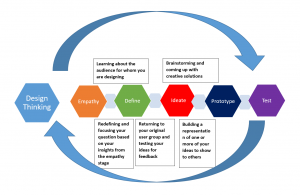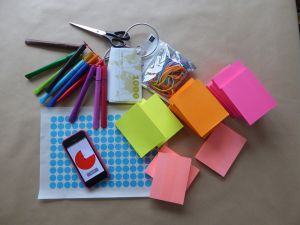Design Thinking
What
- guidelines for a creative process in product design with a user-centered perspective
- iterative process of brainstorming, persona building, prototyping and testing
- was adapted by businesses, research and governance
- how long?
Why & When
- useful if you want to solve a problem
- helps to understand your target group's position
- prevents you from creating a solution when there is no problem
- as a researcher, you can use it to develop solutions for your work life e.g.
Goal(s)
The goal of a
What do you need?
First, you have to decide under which conditions you want to host a design thinking session. What is the topic or the problem you want to work on? Which people and perspectives do you need to go through the process? It is recommendable to not work in larger groups than five, if you are more participants, you can split up in smaller teams and find out with what kind of solutions you come up with. Find a room and organize the material that you need (paper, pen, post-its, whiteboard etc.)
Second, you need to communicate what you expect from the participants: Time, energy, attention. Try to make use that every participant is actually committed as one team member less is easier to work with than somebody dropping in and out.
The Process
Empathise
– with your users
Define
– your users’ needs, their problem, and your insights
Ideate
– by challenging assumptions and creating ideas for innovative solutions
Prototype
– to start creating solutions
Test
– solutions
Rules
-
yes, and: The rule of "yes-and" means, that you should try to build up on each others ideas. Even though you have the impression that the suggestion by your team member is not suitable, add something that makes it fitting
-
quantity first, quality second OR first storm, then criticise: Not everything that is brought up in the process will be the next big thing. Try to not judge ideas and collect everything at first. You can throw out unnecessary stuff later.
-
keep the target in mind: As it happens fast that you get carried away by the brainstorm-thunder, try to get back to the problem description multiple times and check whether your solution fits to the problem and target group. This helps you to stay on track and adjust if necessary.
-
work as one group: You might have the impression that your idea is better than the other one. Try to focus on one idea with the whole group and do not start to do your own thing. Use the attention of the whole group to progress.
-
be visual: Depending on your preference, you can draw an idea, make a mindmap, write everything on post-its or use a written discuss - the most important aspect is: write it down. Therefore, you will have a written documentation later and can get back to ideas that were brought up hours ago.
Links & Further reading
-
https://hpi.de/en/school-of-design-thinking/design-thinking/background/design-thinking-principles.html
- Tips for organizing design thinking sessions: https://newkind.com/12-design-thinking-rules-from-david-burney/
- Conference Paper on Design Thinking Methods: https://link.springer.com/chapter/10.1007/978-3-319-20886-2_2
- Youtube Video about Design Thinking principles (very entrepreneurial): https://www.youtube.com/watch?v=gHGN6hs2gZY

